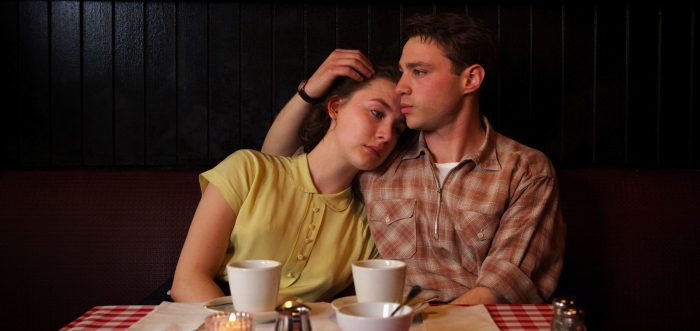A film as understated but radiant and layered as its protagonist, Eilis (Saoirse Ronan), Brooklyn succeeds with a simple storyline whose emotional impact aptly hits home. Director John Crowley and screenwriter Nick Hornby accomplish this impact, this resonance, by placing their confidence in the universality of Eilis’ predicaments, without resorting to cheap plot twists to heighten the stakes. The very source of Brooklyn’s appeal comes from its simple, truthful crises, and the elegant way in which Ronan breathes life into them. Ronan herself never permits Eilis’ soft-spoken character to be outshone by its colourful supporting cast, whose roles extend far beyond two-dimensional caricature. The result is less a slow burn than something like a slow inhale, only to force out a tense exhale from its audience when Eilis is confronted by her hardest decision yet.
In a slight deviation from author Colm Tóibín’s eponymous novel, Eilis is tempted by the prospect of a better life when her sister Rose (Fiona Glascott) arranges work for her in America. With help from a kindly Irish-expat pastor (Jim Broadbent), Eilis uproots herself from the familiar green surrounds of her hometown, to find herself among the brown bricks of Brooklyn. The subsequent homesickness devastates her, despite a job as a store clerk and the amusing antics of her fellow boarders. Her perspective begins to shift after a chance encounter with the charismatic Italian-American Tony (a boyish, charming Emory Cohen), but a family tragedy beckons Eilis home to Ireland and tests her assumptions about her new American life.
On the surface, the film revolves around the idea of binary opposites – largely, America vs. Ireland, by way of Eilis’ two loves – Tony vs. Irishman Jim Farrell (Domhnall Gleeson). Despite the simplicity of its technique, Brooklyn does an apt job of diving beneath this surface, this theme of conflicted loyalties, to unravel the greater concepts at play. What Crowley and Hornby achieve is not only a compelling love-story of the old-fashioned kind, but they choose, tellingly, to make the film’s most pertinent points about Eilis’ self-discovery and journey. When Eilis emerges from her shell, the greater triumph is not her having fallen in love with Tony, rakish American though he is. It’s the new gaze with which she perceives Brooklyn, and America. It’s what Tony represents: a sense of the possibility of rediscovering familiarity and comfort in a formerly foreign place. Crowley and Hornby help to underline this with their inclusion of other, homesick moments in Eilis’ daily life – a mundane shift as a store clerk, eating alone at a diner while brash American accents clamour around her. Saoirse Ronan navigates these moments with a quiet strength that elevates their emotional significance beyond the everyday. Ultimately, the most compelling juxtaposition becomes this: the daunting excitement of a new life, or the ache to slip back into the old, familiar, and comfortable.
Brooklyn also transcends its love-triangle scenario through its discreet use of cyclical patterns, its mirrored images. Certain tableaus recur throughout the film, providing visual emotional cues that do more damage to our hearts than fraught dialogue. In one moment, Eilis and Tony are two tiny figures engulfed in a sea of rippling green grass – a vast wide shot as they survey the empty house plots around them. What they also gaze at is a vision of their future together and what could be. But, fearlessly, cinematographer Yves Bélanger turns this on its head when a similar shot appears in Eilis’ return to Ireland. Accompanied by an old friend, her husband, and a possible new suitor in Jim Farrell, Eilis breathlessly proclaims how she’d forgotten about the beaches in Ireland. Bélanger chooses these visual motifs to imbue moments with a certain emotional complexity that belies what initial purpose they might serve. A moment spent on Long Island, contemplating her future with an American, abruptly becomes tinged with the bittersweet recollection of how much Ireland feels like home when it recurs later on in the film.
Though the film’s focus stays with Eilis throughout, director John Crowley has ensured that Brooklyn doesn’t fall into the trap of similar cinematic fare. That is, it works hard to develop its supporting cast. As a result, the film encompasses Eilis, both in her old home and new, with a lively and varied array of characters. Rather than exist merely to uplift or impede the protagonist, they move throughout the film as defined people in their own right. Julie Walters, as Eilis’ Irish landlady Ma Kehoe, cracks sardonic comments at her boarders, but also shares a glass of sherry with Eilis on Christmas Eve. Tony’s precocious little brother (brought to life by a magnetic young James DiGiacomo) not only ribs Eilis at the dinner table, but helps Tony write letters to her because he’s more literate. It’s an important aspect to the story being told by Crowley and Hornby: there are enough layers to Brooklyn’s other characters that it feels real when Eilis tries to fit into a new way of life and a new place. They exist, they’re there, and Eilis is trying to fit into their world. Otherwise leaving home for America would not feel like so much of a challenge or a revelation for its protagonist.
Brooklyn takes the understated route. But with its formidable cast and meticulous way of playing certain emotional and visual elements against each other, it’s certainly not one we regret.
Around the Staff:
| Harry Windsor | |
| Jess Ellicott | |
| Conor Bateman |

